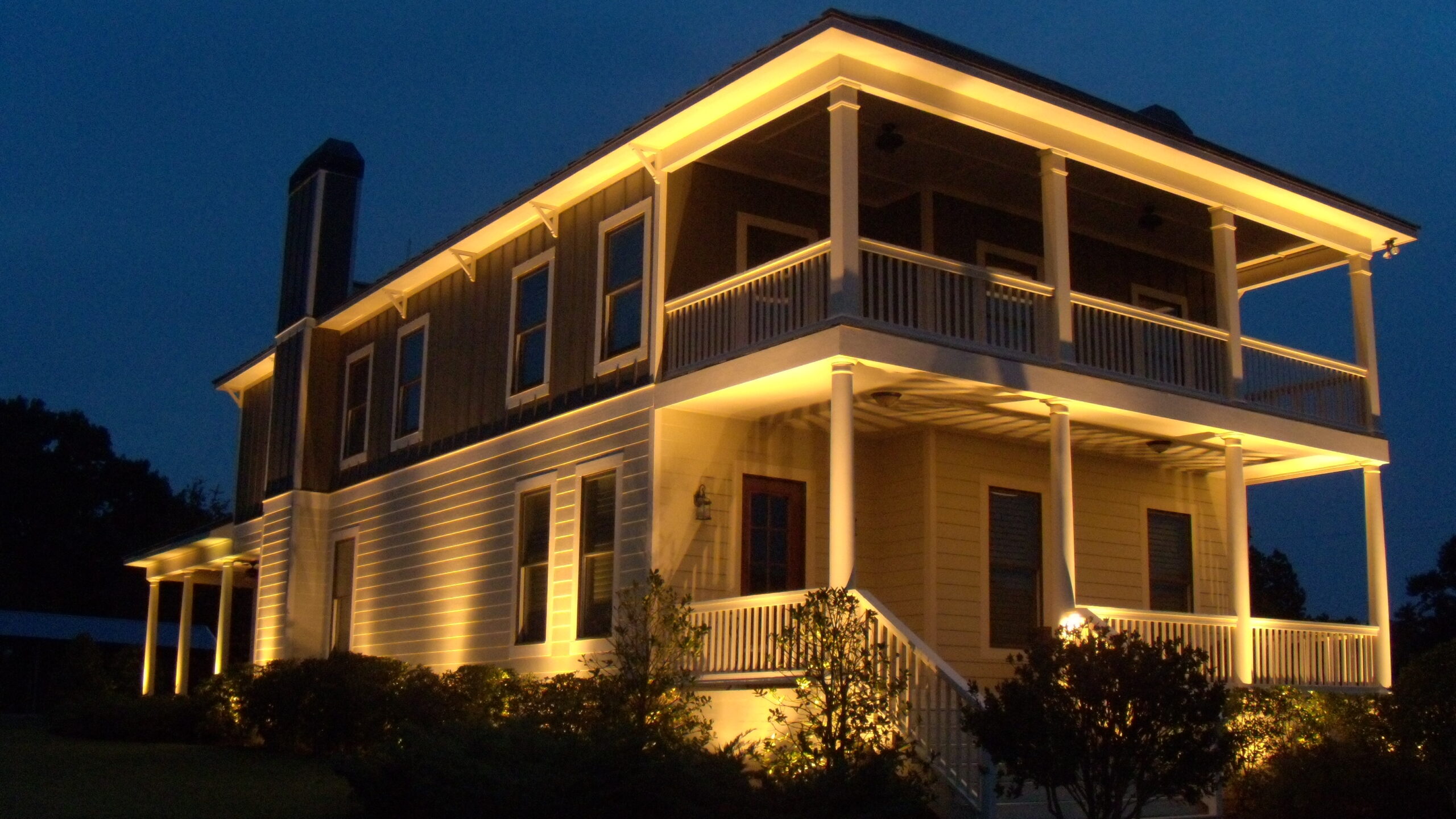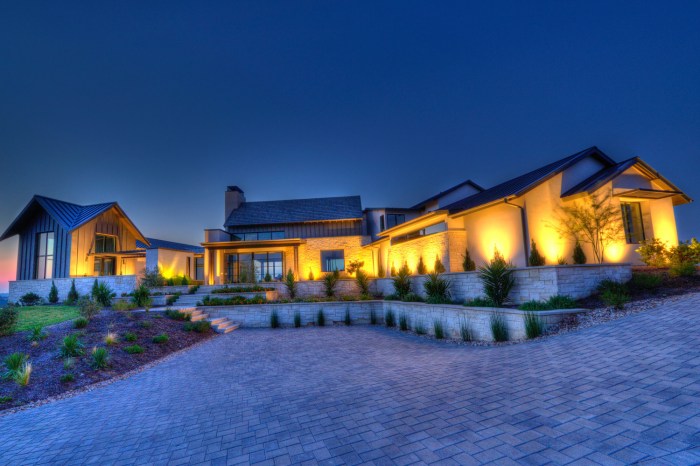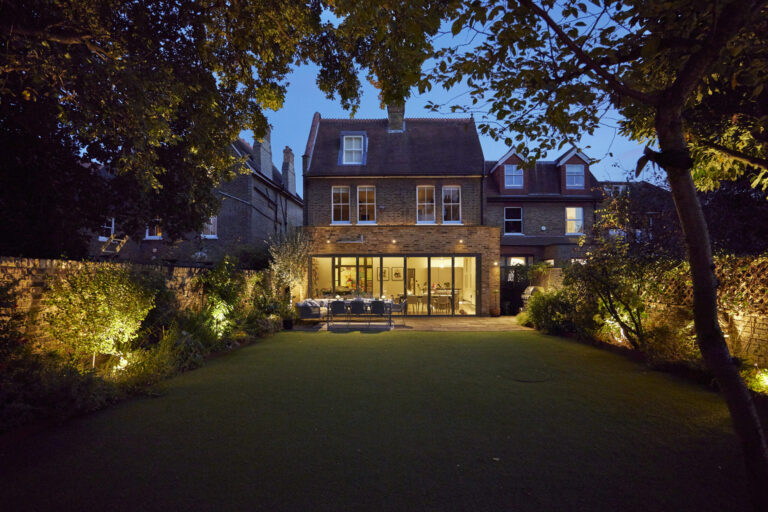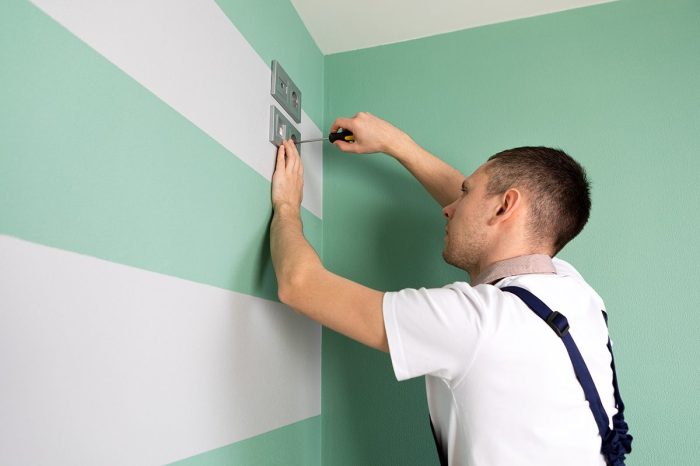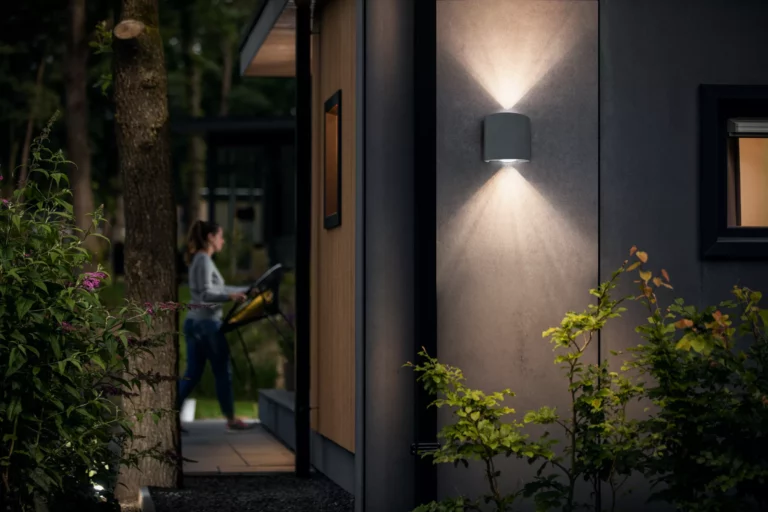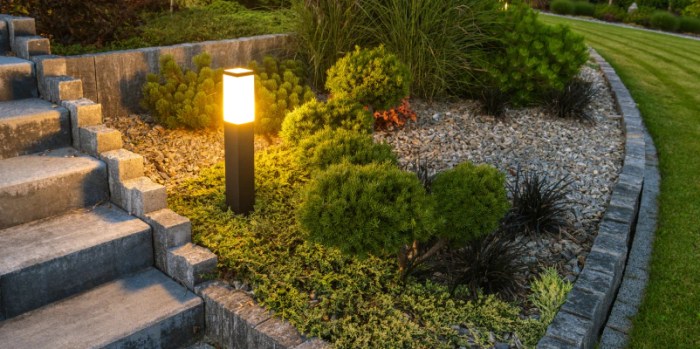Lakeside Lighting and Irrigation A Comprehensive Guide
Lakeside lighting and irrigation are crucial for creating beautiful and functional lakeside environments. This guide delves into the key considerations for designing both systems, ensuring aesthetic appeal and efficiency. From selecting the right lighting fixtures to choosing appropriate irrigation methods, we’ll explore the nuances of integration and sustainability.
This comprehensive guide covers various aspects, including different lighting styles, color temperatures, and strategic placement. It also explores diverse irrigation systems, their advantages and disadvantages, and the best practices for water conservation. We’ll examine the integration of these systems, emphasizing energy efficiency and synchronized operation.
Lakeside Lighting Design Considerations: Lakeside Lighting And Irrigation
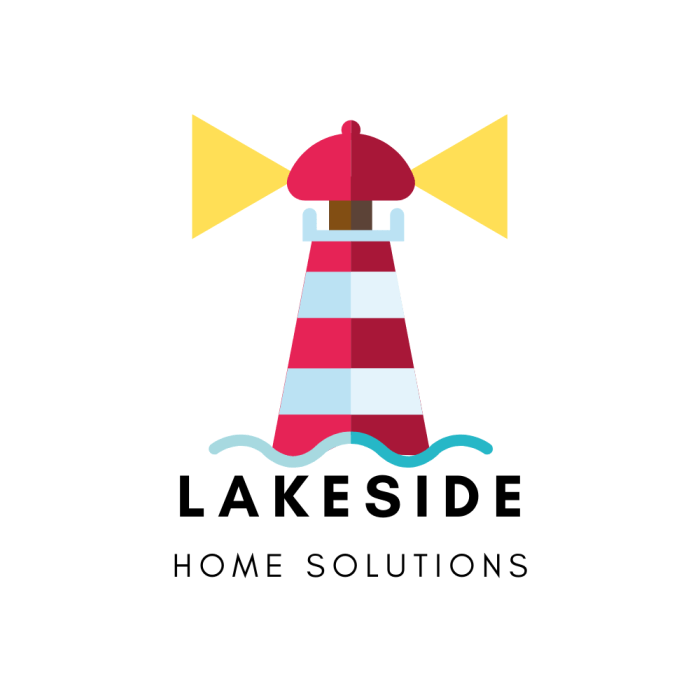
Source: wixstatic.com
Lakeside properties often present unique challenges and opportunities for outdoor lighting design. Careful consideration of lighting style, color temperature, placement, and light pollution mitigation is crucial to create a harmonious blend of functionality and aesthetic appeal. Properly designed lighting enhances the natural beauty of the lakeside setting while also ensuring safety and security.
Effective lighting design for lakeside properties necessitates a nuanced understanding of the interplay between light, water, and architecture. The goal is to create an environment that is both inviting and visually captivating, while minimizing environmental impact.
Lighting Styles for Lakeside Settings
Various lighting styles can be adapted for lakeside properties. Contemporary, minimalist designs can complement modern architecture, while more traditional styles can enhance the charm of historic homes. Consider using a combination of styles to create a cohesive and layered effect. For example, pathway lights with warm-toned LEDs can provide a welcoming glow, while spotlights directed towards architectural features like a gazebo or a stone wall can accentuate their details.
Importance of Light Color Temperature
Light color temperature plays a significant role in shaping the ambiance of a lakeside setting. Warm-toned lights, such as those with a color temperature of 2700 K- 3000 K, create a cozy and inviting atmosphere, perfect for evenings spent relaxing by the water. Cooler-toned lights, such as those with a color temperature of 4000 K- 5000 K, can be more suitable for areas requiring brighter visibility, such as pathways or walkways. Experimenting with different color temperatures allows for a more personalized and appealing atmosphere.
Strategic Placement of Lights
Strategic placement of lights is essential for highlighting architectural features and enhancing the natural beauty of the lakeside landscape. Path lights can guide guests and residents safely along walkways and pathways. Uplighting can draw attention to trees, shrubs, and other landscaping elements. Spotlights can highlight architectural details such as columns, balconies, and facades. Careful planning is necessary to avoid harsh shadows and ensure a balanced illumination of the entire space. A well-placed lamp can transform a simple patio into a captivating focal point.
Minimizing Light Pollution and Maximizing Visibility
Minimizing light pollution is crucial for preserving the natural beauty of the lakeside environment. Using fixtures with downward-facing light distributions and avoiding overly bright or unnecessary illumination can significantly reduce light trespass. Proper shielding of light sources can prevent light from spilling into neighboring properties or affecting wildlife. Careful consideration of light intensity and beam angles ensures adequate visibility without causing discomfort or glare.
Outdoor Lighting Fixture Comparison
| Fixture Type | Material | Style | Energy Efficiency |
|---|---|---|---|
| LED Pathway Lights | Aluminum, cast metal | Modern, traditional | High (low power consumption) |
| Solar-powered Spotlights | Aluminum, plastic | Contemporary, minimalist | Moderate (relies on sunlight) |
| Floodlights | Metal, aluminum | Modern, industrial | Moderate (depends on bulb type) |
| Wall-mounted Lanterns | Metal, glass | Traditional, rustic | Moderate (depends on bulb type) |
This table provides a concise comparison of various outdoor lighting fixtures, considering their material composition, design aesthetic, and energy efficiency. Different materials and styles cater to diverse architectural preferences and budgetary constraints. Selecting energy-efficient options contributes to long-term cost savings and a reduced environmental impact.
Irrigation Systems for Lakeside Properties
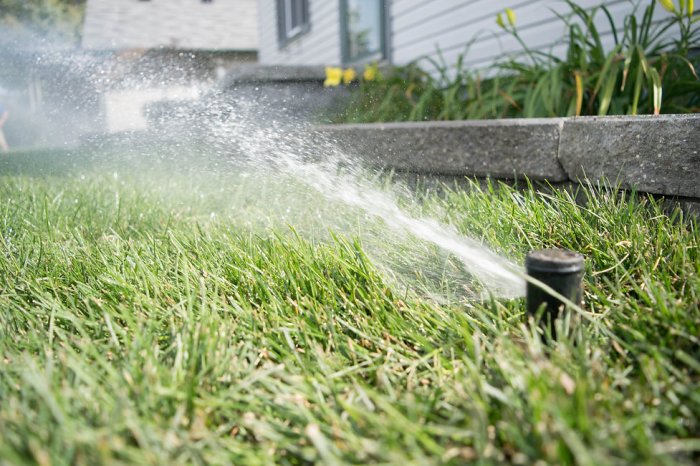
Source: wixstatic.com
Landscaping around lakes often presents unique challenges for irrigation. The presence of water features and varying soil conditions necessitates careful consideration of the irrigation system to ensure optimal plant health and water efficiency. Properly designed systems are crucial for maintaining lush greenery and preventing water waste, especially in areas with limited water resources.
Irrigation systems for lakeside properties must address the specific needs of the landscape, taking into account factors such as soil type, plant species, and water availability. Careful selection and installation are paramount for long-term success. Integration with the overall lighting design is also critical to ensure both aesthetic appeal and functional efficiency.
Irrigation System Types
Different irrigation systems offer varying benefits and drawbacks. Understanding these distinctions is essential for making informed decisions. Drip irrigation, sprinkler systems, and soaker hoses are common choices, each with unique advantages and disadvantages.
- Drip irrigation delivers water directly to the roots of plants, minimizing water loss to evaporation and runoff. This method is particularly effective for precise watering and can significantly reduce water consumption compared to other methods. It’s well-suited for specific plant types and controlled watering needs. However, installation can be more complex, and specialized tubing and emitters are required. Careful planning and precise placement of emitters are crucial to ensure uniform watering.
- Sprinkler systems utilize overhead sprinklers to distribute water over a wider area. This method is commonly used for larger lawns and gardens. The ease of installation and broader coverage are major advantages. However, water loss through evaporation and runoff can be significant, and sprinkler systems may not be as effective at reaching specific plant types or areas. Proper sprinkler head selection and adjustments for wind conditions are important.
- Soaker hoses deliver water directly to the soil, promoting deep watering and minimizing evaporation. They are often used for established lawns and gardens with a well-established root system. The method provides a good balance between coverage and water conservation. Soaker hoses are generally less costly than other options, but they may not be as effective for larger or uneven landscapes. Installation requires careful consideration of the terrain and water pressure.
Sprinkler Head Types
The choice of sprinkler head significantly impacts the effectiveness and efficiency of the irrigation system. Selecting the right type for specific landscaping features is crucial.
| Sprinkler Head Type | Application | Advantages | Disadvantages |
|---|---|---|---|
| Spray heads | General lawn areas | Wide coverage, relatively inexpensive | Higher water waste potential, less precise watering |
| Rotor heads | Larger lawns, uneven terrain | Good coverage, adjustability | Can be less efficient than other heads, higher cost |
| Pop-up heads | Specific areas, flowerbeds, or shrubs | Precise targeting, adjustable spray patterns | It can be more expensive, and installation requires more planning |
| Micro-sprinklers | Precise watering of specific plants, small gardens | High efficiency, minimal water waste | More complex installation, higher cost |
Water Conservation Techniques, Lakeside lighting, and irrigation
Water conservation is paramount in lakeside landscaping. Minimizing water usage is critical, particularly in areas with water restrictions.
Implementing smart irrigation scheduling, using drought-tolerant plants, and regularly checking for leaks are vital steps. Utilizing rain barrels to collect rainwater and re-using graywater can further reduce water consumption. Proper maintenance of the irrigation system, including regular checks for leaks, will also aid in conserving water.
Cost-Effectiveness of Irrigation Systems
The cost-effectiveness of irrigation systems varies based on factors like system size, features, and installation complexity. Drip irrigation typically has a higher initial cost but can reduce long-term water bills through efficiency. Sprinkler systems offer a balance between cost and coverage, while soaker hoses generally have a lower upfront cost.
Designing a Lakeside Irrigation System
Integrating the irrigation system with the lighting plan is essential for optimal aesthetics and functionality. Coordination ensures that both systems complement each other, creating a cohesive and visually appealing lakeside landscape. Consider using timers and sensors for both irrigation and lighting systems to optimize water usage and energy efficiency. Strategic placement of both irrigation heads and lights can significantly improve the overall look and function of the property.
Integration of Lighting and Irrigation
Integrating lighting and irrigation systems on lakeside properties offers significant advantages, enhancing both aesthetic appeal and operational efficiency. Proper coordination between these systems can lead to optimized water usage, reduced energy consumption, and a more harmonious ambiance. Careful planning and execution are crucial for realizing these benefits.
A well-integrated system allows for synchronized operation of lighting and irrigation, enabling precise control based on environmental factors and user preferences. This synchronization minimizes wasted resources and maximizes the impact of both systems. The focus should be on achieving optimal performance while maintaining a responsible approach to water and energy usage.
Detailed Plan for Integrating Systems
To effectively integrate lighting and irrigation, a detailed plan is essential. This plan should encompass the selection of appropriate equipment, the design of control systems, and the establishment of operational procedures. This comprehensive approach ensures that the systems work in harmony, contributing to the overall aesthetic and functionality of the lakeside property. Careful consideration of energy efficiency is paramount throughout the planning process.
Importance of Synchronized Operation
Synchronizing lighting and irrigation systems is vital for several reasons. First, it allows for the strategic use of lighting to accentuate the beauty of the landscape when water is being used for irrigation. This can create a captivating visual effect, particularly at night. Second, it minimizes wasted energy and water resources. For instance, lighting should be automatically adjusted based on the time of day and weather conditions.
Optimizing Water Usage and Light Output
Optimizing water usage and light output is crucial for maximizing the impact of both systems while reducing costs. This can be achieved through the use of advanced sensors and automated control systems. These systems can adjust irrigation schedules based on factors such as soil moisture levels, rainfall, and time of day. Similarly, light intensity can be dynamically adjusted based on ambient light conditions.
Examples of Different Control Scenarios
Several scenarios can be implemented to control both systems using sensors or timers. One example is using soil moisture sensors to trigger irrigation only when necessary. The lighting system could be programmed to turn on automatically at dusk and adjust intensity based on ambient light levels. Another approach is using a weather sensor to adjust both systems in response to precipitation. This proactive approach ensures that both systems are operating efficiently and responsibly. This approach ensures water and energy conservation.
Table of Control Systems
| Control System | Description | Pros | Cons |
|---|---|---|---|
| Manual | Operated manually by a user. | Simple to implement. | Inefficient, prone to human error, and does not account for environmental factors. |
| Automated (Timers) | Systems are set to operate on predetermined schedules. | Simple to implement, suitable for basic needs. | Does not adapt to real-time conditions, less energy-efficient. |
| Sensor-Based | Systems are controlled by sensors that monitor environmental factors (moisture, light, weather). | Highly efficient, adaptable to various conditions. | Requires more complex setup and potentially higher initial cost. |
Environmental Impact and Sustainability
Lakeside properties, with their inherent beauty and tranquility, often require sophisticated lighting and irrigation systems. However, these systems can have a significant environmental impact. Careful consideration of sustainable practices is crucial to minimizing harm to the ecosystem and preserving the natural beauty of the lakefront.
Choosing environmentally responsible lighting and irrigation systems is not just a matter of ethical considerations; it is also a practical approach to long-term property value and community well-being. Effective and sustainable practices lead to reduced operating costs, minimized environmental damage, and a positive contribution to the overall ecological balance of the area.
Environmental Impact of Lighting Choices
Lighting choices significantly affect light pollution and energy consumption. Traditional high-intensity discharge (HID) fixtures, while providing bright illumination, often consume substantial amounts of energy and emit significant amounts of light pollution, affecting nocturnal wildlife. Switching to energy-efficient LED lighting options dramatically reduces energy consumption and light trespass.
Sustainable Lighting Options for Lakeside Settings
LED lighting stands out as a leading sustainable choice. Their energy efficiency surpasses traditional lighting technologies, reducing electricity bills and greenhouse gas emissions. Solar-powered LED fixtures further enhance sustainability by harnessing renewable energy. These systems use photovoltaic panels to convert sunlight into electricity, minimizing reliance on the electrical grid and lowering carbon footprints.
Environmentally Friendly Irrigation Practices
Efficient irrigation systems are crucial for responsible water management. Drip irrigation, for instance, delivers water directly to the plant roots, minimizing water loss through evaporation and runoff. Smart irrigation controllers can adjust watering schedules based on real-time weather conditions, preventing overwatering and conserving water.
Minimizing Water Waste and Light Pollution
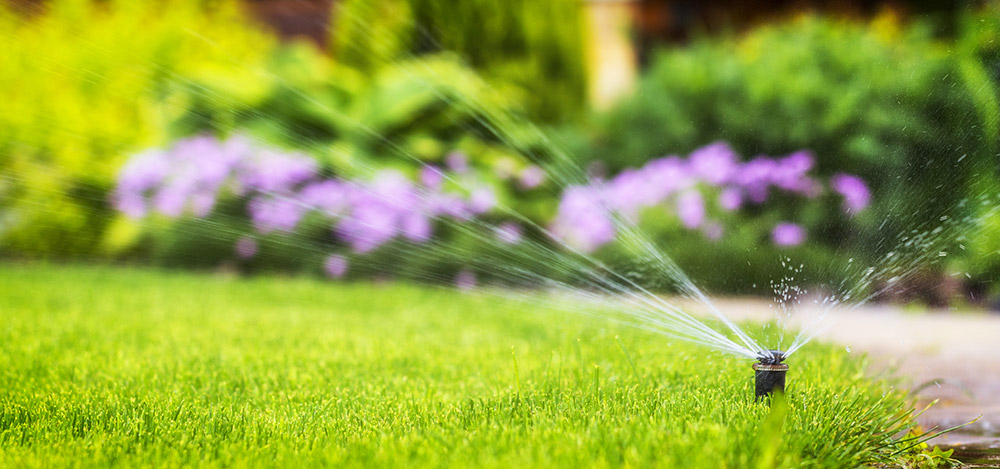
Water waste can be minimized through several strategies. Implementing rainwater harvesting systems can supplement water supplies and reduce reliance on freshwater sources. Regular maintenance of irrigation systems, including checking for leaks and ensuring proper function, is essential to prevent water loss.
Responsible Water Usage and Reduced Environmental Footprint
Responsible water usage is a crucial element of sustainability. Using drought-tolerant landscaping native to the region minimizes water requirements and reduces the need for frequent watering. Careful planning of the landscape layout, considering the specific needs of different plants, can further optimize water use. Water-wise landscaping can significantly decrease water consumption compared to traditional methods. Additionally, implementing efficient lighting strategies, such as motion sensors and timers, will reduce light pollution and energy consumption.
Maintenance and Troubleshooting
Maintaining lakeside lighting and irrigation systems requires proactive measures to ensure longevity and optimal performance. Regular upkeep prevents costly repairs and ensures the beauty and functionality of the property. This section details crucial procedures for maintaining these systems.
Regular Maintenance of Lakeside Lighting Fixtures
Regular inspections and cleaning of lighting fixtures are essential to prevent malfunctions and maintain their aesthetic appeal. This includes checking for loose connections, damaged components, and any signs of corrosion. Proper cleaning methods are crucial to maintaining the fixtures’ reflectivity and lifespan. Using appropriate cleaning solutions and tools is vital to avoid scratching or damaging the finish.
- Inspect fixtures for loose connections, damaged wires, or signs of corrosion. These issues, if left unaddressed, can lead to electrical hazards or premature failure.
- Clean fixtures regularly using appropriate cleaning solutions and tools to remove dirt, grime, and debris. This prevents a build-up that can reduce light output and potentially damage the fixture.
- Check for any signs of water intrusion around the fixtures. Water damage can cause electrical malfunctions and corrosion.
- Ensure the fixtures are securely mounted and the supporting structures are intact. Poorly secured fixtures can lead to accidents and damage.
Potential Issues with Irrigation Systems and Troubleshooting
Irrigation systems can experience various issues, ranging from minor clogs to significant leaks. Troubleshooting these issues promptly is crucial to avoid water waste and potential damage to the landscape. Early detection and correction are vital for the long-term health of the system and the surrounding environment.
- Clogs: Inspect the pipes and emitters for clogs. These clogs can be caused by debris, minerals, or other foreign materials. Use appropriate tools and techniques to remove clogs. Use water pressure to clear minor clogs or specialized cleaning solutions for more stubborn blockages.
- Leaks: Regularly check for leaks in pipes, fittings, and valves. Leaks can lead to water waste and potential damage to the surrounding area. Identify the source of the leak and repair it promptly.
- Low Water Pressure: Low water pressure can indicate a problem with the water source, a restriction in the pipes, or a faulty pump. Check the water source and ensure there aren’t any restrictions. Verify that the pump is functioning correctly.
- Incorrect Watering Schedules: Ensure that the irrigation system is programmed for the specific needs of the plants. Adjust the schedules based on the time of year and weather conditions to optimize watering. This prevents over-watering or under-watering.
Preventing Damage to Fixtures and Irrigation Equipment
Proactive measures can significantly reduce the risk of damage to both lighting fixtures and irrigation equipment. Regular inspections and proper maintenance are key preventative measures.
- Protect fixtures from extreme weather conditions. Consider using weather-resistant enclosures for vulnerable components or ensuring proper drainage around the fixture. Wind and extreme temperatures can cause damage.
- Properly insulate electrical wiring to prevent electrical hazards. Ensure all wiring meets safety standards and is properly insulated.
- Use appropriate materials and techniques when working on the irrigation system. Using the correct tools and equipment minimizes the risk of damage to the system and surrounding areas.
Troubleshooting Table
| Problem | Solution |
|---|---|
| Loose connections | Tighten connections using appropriate tools. |
| Clogged pipes | Use specialized cleaning tools to clear clogs. |
| Low water pressure | Check the water source, ensure no restrictions in pipes, and verify the pump function. |
| Electrical malfunction | Consult a qualified electrician for diagnosis and repair. |
| Fixture damage | Replace damaged parts or the entire fixture. |
Best Practices for Addressing Issues
Addressing water pressure, leaks, and electrical malfunctions requires a systematic approach. This includes identifying the source of the issue, implementing appropriate solutions, and preventing future problems.
- Water Pressure Issues: Check the water source, ensure pipes are clear of blockages, and verify pump functionality. If necessary, contact a water utility specialist.
- Leaks: Identify the leak source, repair damaged pipes or fittings, and implement preventative measures to avoid future leaks.
- Electrical Malfunctions: Contact a qualified electrician to diagnose and repair electrical problems. Never attempt to fix electrical issues yourself unless you have the necessary expertise and safety precautions.
Case Studies and Examples
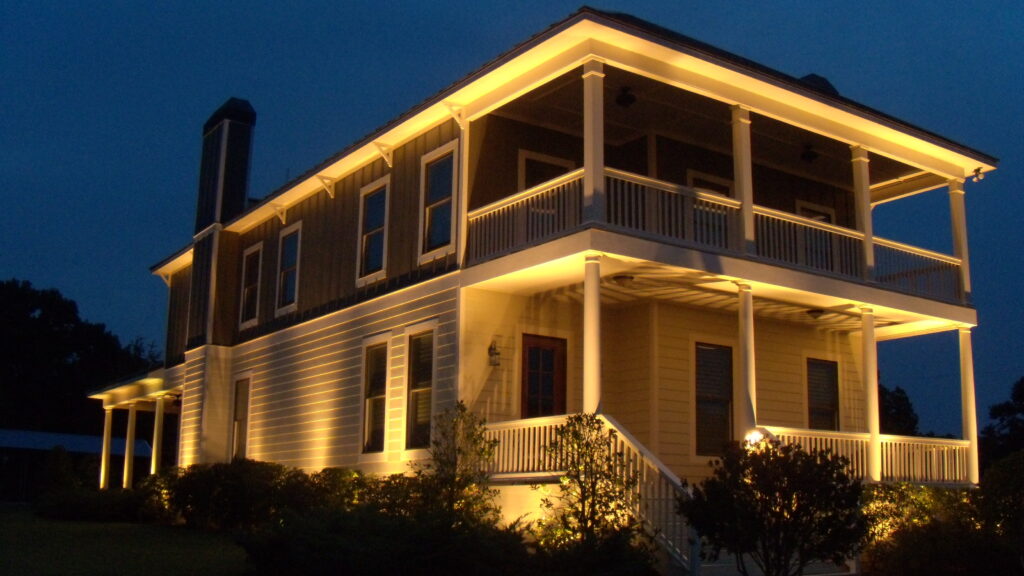
Lakeside properties often require specialized lighting and irrigation systems to enhance aesthetics and maintain the landscape’s health. Case studies provide valuable insights into successful installations, showcasing different design approaches and their outcomes. These examples highlight the importance of considering factors like budget, environmental impact, and long-term maintenance when planning such projects.
Successful lakeside installations demonstrate that careful planning and design choices can significantly improve the overall appeal and functionality of the property. By studying various approaches, property owners and designers can adapt and implement effective strategies for their specific needs.
Successful Lakeside Lighting Installations
Effective lighting design significantly impacts the ambiance and safety of a lakeside property. Careful consideration of light color, intensity, and placement is crucial for both visual appeal and functionality. A well-executed plan can create a serene atmosphere at night, highlighting the beauty of the water and the surrounding landscape.
- Project A: This installation utilized LED path lighting with adjustable color temperature. Warm white lights were used along the walkways, transitioning to cooler white lights near the water’s edge. This approach created a dynamic and inviting ambiance, minimizing light pollution and maximizing visual impact.
- Project B: This project focused on highlighting architectural features. Spotlights were strategically placed to accentuate the house’s facade and unique landscaping elements, such as trees and sculptures. This technique emphasized the property’s unique design while creating a dramatic effect.
Irrigation Systems for Lakeside Properties
Lakeside properties often face unique irrigation challenges due to the presence of water bodies. Designing an effective irrigation system must consider water conservation and efficient delivery to the plants.
- Project C: This project used a drip irrigation system specifically designed for the unique soil and plant types found along the lake. The drip system’s precise water delivery method minimized water waste and ensured optimal hydration for the plants. The system was also integrated with a weather monitoring system to adjust watering schedules based on rainfall patterns.
Integration of Lighting and Irrigation
Integrating lighting and irrigation systems creates a harmonious blend of functionality and aesthetic appeal. Effective integration often reduces maintenance and optimizes resource usage.
- Project D: This project integrated a timed irrigation system with the lighting system. The lights automatically turned on as the irrigation system started, creating a captivating display of water features. This synchronized approach enhanced the visual impact of the landscape, particularly at night.
Comparative Analysis of Lakeside Installations
A comparison of various installations can highlight the trade-offs between cost, aesthetics, and sustainability.
| Installation | Cost | Aesthetics | Sustainability |
|---|---|---|---|
| Project A | Moderate | High | Medium |
| Project B | High | High | Medium |
| Project C | Low | Medium | High |
| Project D | High | High | High |
Ending Remarks
In conclusion, creating a beautiful and sustainable lakeside environment involves careful consideration of both lighting and irrigation. This guide has provided a framework for designing integrated systems, optimizing water usage, and minimizing environmental impact. From selecting appropriate fixtures to implementing effective irrigation methods, we’ve explored the essential elements for a successful lakeside project. Ultimately, a well-planned and maintained lakeside setting will enhance the beauty and functionality of the property for years to come.
